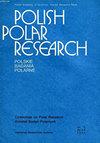Expression patterns of molecular chaperone genes in Antarctic psychrophilic yeast, Glaciozyma antarctica PI12 in response to heat stress
IF 0.8
4区 地球科学
Q4 ECOLOGY
引用次数: 1
Abstract
: Microbes living in the polar regions have some common and unique strategies to respond to thermal stress. Nevertheless, the amount of information available, especially at the molecular level is lacking for some organisms such as Antarctic psychrophilic yeast. For instance, it is not known whether molecular chaperones in Antarctic yeasts play similar roles to those from mesophilic yeasts when they are exposed to heat stress. Therefore, this project aimed to determine the gene expression patterns and roles of molecular chaperones in Antarctic psychrophilic Glaciozyma antarctica PI12 that was exposed to heat stress. G. antarctica PI12 was grown at its optimal growth temperature of 12ºC and later exposed to heat stresses at 16ºC and 20ºC for 6 hours. Transcriptomes of those cells were extracted, sequenced and analyzed. Thirty-three molecular chaperone genes demonstrated differential expression of which 23 were up-regulated while 10 were down-regulated. Functions of up-regulated molecular chaperone genes were related to protein binding, response to a stimulus, chaperone binding, cellular response to stress, oxidation, and reduction, ATP binding, DNA-damage response and regulation for cellular protein metabolic process. On the other hand, functions of down-regulated molecular chaperone genes were related to chaperone-mediated protein complex assembly, transcription, cellular macromolecule metabolic process, regulation of cell growth and ribo-some biogenesis. The findings provided information on how molecular chaperones work together in a complex network to protect the cells under heat stress. It also highlights the evolutionary conserved protective role of molecular chaperones in psychrophilic yeast, G. antarctica , and cerevisiae .南极嗜冷酵母,Glaciozyma antarctica PI12分子伴侣基因在热胁迫下的表达模式
本文章由计算机程序翻译,如有差异,请以英文原文为准。
求助全文
约1分钟内获得全文
求助全文
来源期刊

Polish Polar Research
ECOLOGY-GEOSCIENCES, MULTIDISCIPLINARY
CiteScore
2.00
自引率
7.70%
发文量
0
审稿时长
>12 weeks
期刊介绍:
The quarterly Polish Polar Research edited by the Committee on Polar Research of the Polish Academy of Sciences is an international journal publishing original research articles presenting the results of studies carried out in polar regions.
All papers are peer-reviewed and published in English.
The Editorial Advisory Board includes renowned scientist from Poland and from abroad.
 求助内容:
求助内容: 应助结果提醒方式:
应助结果提醒方式:


